Apr 1, 2018 | coins, foreign
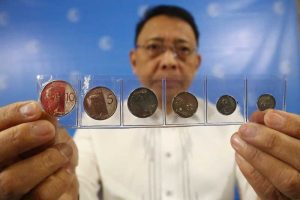
Philippines Rep. Jericho Nograles holds newly release BSP coins noting they “are misleading the public and are causing a lot of confusion.” (Miguel de Guzman of the Philippines Star.)
For those who did not have the pleasure of accidentally spending the dollar coin as a quarter, the Susie B. was too close to the size to the Washington quarter, had reeded edges like the Washington quarter, and on a simple glance was consistently confused with the Washington quarter. The confusion made the coin very unpopular in the United States even though it continues to find usage in other countries whose currency is based on the U.S. dollar.
In the Philippines, the BSP made the mistake of making the one-peso and five-peso coins very similar in size, look, and feel. It is so bad that a member of the Philippines Congress is urging the BSP to recall the coins.
“Basic design principles for coinage demand that the denominations are easy to distinguish not just visually, but also through touch or tactile differences,” said Rep. Jericho Nograles. “Our new coins fail in these principles.”
The story almost reads like discussions others have had with coin design issues when Nograles asks, “Did the BSP consider jeepney, pedicab, tricycle and taxi drivers? Did they consider the visually impaired, and senior citizens, at all?”
They likely did not and will have to be dragged into reality kicking and screaming like the Bureau of Engraving and Printing had to be over the same issues.
And now the news…

March 25, 2018
You may want to check your pockets to look for one of the most elusive Korean coins there is — the 1998 500 won coin. Though the odds of you finding one of these coins is almost nil, you never know when you might just hit the jackpot — stranger things have happened.  → Read more at korea.stripes.com
→ Read more at korea.stripes.com

March 26, 2018
A hoard of rare bronze Jewish Revolt coins has been discovered at the recently renewed Ophel excavations. The trove of dozens of bronze coins minted during the last years of the ill-fated four-year rebellion of the Jews against Roman rule was uncovered in a cave just south of the Temple Mount by Hebrew University archaeologist Dr.  → Read more at timesofisrael.com
→ Read more at timesofisrael.com

March 27, 2018
KUMAGAYA, Saitama Prefecture — One of the biggest hauls of medieval coins ever discovered in Japan has been unearthed in Saitama Prefecture. Tens of thousands of bronze coins were found in a buried ceramic jar believed to date back to the first half of the 15th century.  → Read more at asahi.com
→ Read more at asahi.com

March 28, 2018
MANILA, Philippines — Rep. Jericho Nograles of party-list group Puwersa ng Bayaning Atleta yesterday urged the Bangko Sentral ng Pilipinas (BSP) to immediately recall all its newly released coins due to “serious design flaws.”  → Read more at philstar.com
→ Read more at philstar.com

March 28, 2018
The first coins to be issued marking the reign of King Rama X will be put into circulation on April 6, Finance Minister Apisak Tantivorawong said on Wednesday. The new coins would replace existing coins, which were exiting the economy.  → Read more at bangkokpost.com
→ Read more at bangkokpost.com

March 28, 2018
The decision of the Bangko Sentral ng Pilipinas to introduce a new series of coins was meant to deter foreign entities from stealing large quantities of the local specie to extract their nickel content.  → Read more at business.inquirer.net
→ Read more at business.inquirer.net

March 29, 2018
The Queen carries out the Royal Maundy service at Windsor Castle without the Duke of Edinburgh.  → Read more at bbc.com
→ Read more at bbc.com

March 30, 2018
Three new glow-in-the-dark starship coins are coming soon, courtesy of the Royal Canadian Mint.  → Read more at trektoday.com
→ Read more at trektoday.com
Mar 25, 2018 | coins, foreign, news
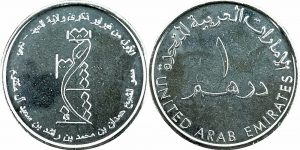
2015 1 Dirham coin from the UAE celebrating the Accession Day of His Highness Sheikh Hamdan bin Mohamed bin Rashid bin Saeed Al Maktoum, Crown Prince of Dubai (Image courtesy of Numista)
In the original article, Nihad Hassan, an Indian living in the Abu Dhabi, liked the design of the Dh1 coins and started collecting them. One coin that was difficult to find was the 2015 Dh1 coin issued to celebrate the seventh anniversary of the accession of Sheikh Hamdan bin Mohammed as Crown Prince of Dubai. As part of the article, he asked if someone could help him find a coin.
This past week, The National reported that an Indian working in a local grocery store found the coin and gave it to Hassan.
The original report was seen around the country and helped gain attention. Hassan reported that he received many emails offering to sell the coin to others who wanted to just give the young numismatist the coin in order to encourage him and his hobby.
Could this be a lesson to encourage more people to look at their coins, especially here in the United States? What if more media outlets wrote about young collectors and allowed members of the public to donate the coins to help these budding collectors complete their collection? Could hobby shops of all types that buy from the public use their space to create collections of state or national park quarters that will be given to younger children to learn about collecting? What if the store created a credit system whereby you bring the coins and you get a store credit?
It would be a form of community collecting. Maybe the collections could be auctioned for charity. Something for those in business to think about.
And now the news….

March 16, 2018
A young numismatist in search of a rare coin has had the elusive bit donated to his collection after members of the community heard his story and rallied around to help. Nihad Hassan had been searching for the Dh1 coin that was issued in 2015 on the seventh anniversary of the accession of Sheikh Hamdan bin Mohammed as Crown Prince of Dubai.  → Read more at thenational.ae
→ Read more at thenational.ae

March 17, 2018
Prince Charles is getting a special £5 coin made to celebrate his 70th birthday. The Queen has also ordered a £25 platinum coin to commemorate the special occasion. The prince has already had special currency made for his first wedding and 50th and 60th birthdays so it doesn’t come as a huge surprise he’s getting more.  → Read more at metro.co.uk
→ Read more at metro.co.uk

March 17, 2018
The government has ruled out scrapping 1p and 2p coins, despite launching a consultation into the use of cash. And if you’re among the 60% of people who immediately save, lose or even throw out pennies you receive, think again – these small coins can be worth more than you think.  → Read more at which.co.uk
→ Read more at which.co.uk

March 19, 2018
In 2007 Alexander Shapovalov suggested an unusual coin-weighing problem for the sixth international Kolmogorov math tournament [5]. A judge is presented with 80 coins that all look the same, knowing that there are either two or three fake coins among them.  → Read more at scientificamerican.com
→ Read more at scientificamerican.com

March 19, 2018
Mickey Mouse money became, from Tuesday, legal tender in France, after the national mint, Monnaie de Paris, released a series of commemorative coins bearing the image of Disney's iconic cartoon creation.  → Read more at connexionfrance.com
→ Read more at connexionfrance.com

March 20, 2018
A contest is now underway honoring one of the Capital Region’s greatest war heroes. Ferris Coin Company in Albany announced they’re handing out two $1,000 prizes for whoever can design the best commemorative coin for the late Sergeant Henry Johnson, who served in World War I.  → Read more at cbs6albany.com
→ Read more at cbs6albany.com

March 20, 2018
Much of the information in this article is from "The Mint on Carson Street," by Rusty Goe. Whenever I take people on tours through the Nevada State Museum, one of my favorite exhibits is the original coin press and the nearly complete collection of gold and silver Carson City coins minted there.  → Read more at nevadaappeal.com
→ Read more at nevadaappeal.com

March 22, 2018
The United States Mint recently released a new limited edition coin under its Breast Cancer Awareness Commemorative Coin Program to increase awareness of breast cancer and raise funds for research, according to a press release.  → Read more at breastcancer-news.com
→ Read more at breastcancer-news.com

March 22, 2018
Video It could be a story line straight out of the hit television series Detectorists. But instead of Mackenzie Crook and Toby Jones in the leading roles, the stars of this show are Norwich residents Damon Pye and his wife Denise.  → Read more at edp24.co.uk
→ Read more at edp24.co.uk

March 25, 2018
A 1787 New York Brasher Doubloon, one of the first gold coins to be struck in the United States, has been sold for more than $5 million (£3.  → Read more at telegraph.co.uk
→ Read more at telegraph.co.uk
Jan 26, 2018 | currency, foreign, history
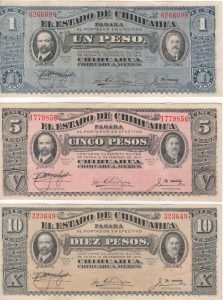 This past week, I was looking into a box I purchased from an estate and I found a plastic bag of old foreign currency. When I removed the notes, I found common notes that can usually be purchased from estate especially since he was a career military officer. There was everything from German Notgeld to several European and Asian countries.
This past week, I was looking into a box I purchased from an estate and I found a plastic bag of old foreign currency. When I removed the notes, I found common notes that can usually be purchased from estate especially since he was a career military officer. There was everything from German Notgeld to several European and Asian countries.
During my search, I found three notes that were intriguing. All three notes were from El Estado de Chihuahua, the State of Chihuahua. They were beautifully preserved (albeit with a fold down the center) one-, five-, and ten-peso notes with the same design but in different colors.
Under the printed denomination are the words “Conforme al Decreto Militar de Fecha Io de Febrero de 1914” (Pursuant to the Military Decree dated February 1914). I vaguely remember that was the era of Pancho Villa and his romp through the southwest United States. Time to refresh my history.
After the 35-yearlong regime of Porfirio Diaz, he was challenged in the presidential election by Francisco I Madero in 1910. Madero was in favor of reform and social justice. But Diaz fixed the election declaring he won by a landslide.
Before the election Diaz had Madero jailed and when it became obvious the election was fixed, Madero supporter Toribio Ortega formed a militia in Chihuahua to oust Diaz.
While in jail, Madero issued a “letter from jail” that declared the Diaz presidency illegal and called for a revolt against Diaz. The revolt began in November 1910. Diaz was ousted and a new election was held in October 1911 that elected Madero the 33rd President of Mexico.
Mexico was divided into districts managed by different governments and protected by rebel leaders including Pascual Orozco, Pancho Villa, and Emiliano Zapata. Eventually, they turned on Madero and assassinated him on February 13, 1913.
The United States first played a role in 1914 when Pancho Villa plundered parts of New Mexico. In 1916, Gen John J. Pershing was sent to Mexico to capture Villa but could not do so since Villa was hiding in the mountains of northern Mexico. Pershing was able to get some of the fighting to stop and, along with the Catholic Church and several affiliated political parties, forced the negotiation of the Constitution of 1917.
Although the notes were authorized in February 1914, the Chihuahua government did not have the ability to print notes. Eventually, they contracted with the American Banknote Company to produce the notes. They were issued in 1915.
To expedite production, all notes feature the same design engraved with different denominations and printed using different colored inks. Many of the elements used were standard to American Banknote’s catalog, for these notes, the portrait on the left is of Francisco I. Madero and the portrait on the right is Governor Abraham Gonzalez. Each features three signatures of the Tesorero General (General Treasury), Gobernator (Governor), and Interventor (Controller). As with many signatures, it is difficult to interpret their names from the handwriting. Please contact me if you have more information.
-
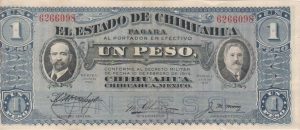
-
Chihuahua Revolutionary 1 Peso Banknote. 1915 Series L (SCWPM #PS530e)
-
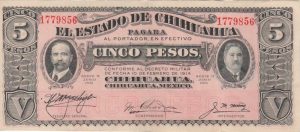
-
Chihuahua Revolutionary 5 Pesos Banknote. 1915 Series N (SCWPM #PS532e)
-
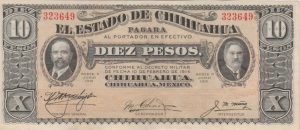
-
Chihuahua Revolutionary 10 Pesos Banknote. 1915 Series N (SCWPM #PS535a)
Reverse if these notes feature a framed picture of the Palacio de Gobierno do Chihuahua (Government Palace of Chihuahua) held by two griffins. When the notes were issued from the banks in Chihuahua, they received a red stamp from Tesorero General del Estado Chihuahua (General Treasury of the State of Chihuahua) along with the stamped initials of the issuing teller. When the notes were issued, the teller was supposed to stamp the date on the reverse but that was not universally practiced.
-
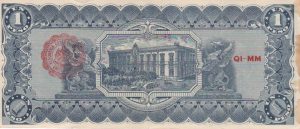
-
Chihuahua Revolutionary 1 Peso Banknote. 1915 Series L (SCWPM #PS530e)
-

-
Chihuahua Revolutionary 5 Pesos Banknote. 1915 Series N (SCWPM #PS532e)
-

-
Chihuahua Revolutionary 10 Pesos Banknote. 1915 Series N (SCWPM #PS535a)
In addition to the one-, five-, and ten-peso notes, the Chihuahua government issued 20- and 50-peso notes as well as a 50-centavos fractional note. Both the 20- and 50-peso notes featured the same design except the 20-peso note was printed using brown ink and the 50-peso was printed with a bright green on the front and a golden yellow on the reverse.
The 50-centavo fractional note used a different design and was smaller than the pesos. It was also printed by the American Banknote Company.
These notes were demonetized in 1917 with the signing of the new constitution.
An Educational Opportunity
Money is history in your hands. Look at what can be learned from finding three banknotes and exploring their past and how they fit into history.
Here is an idea for history teachers: you can go to any coin show and find a dealer with a junk box of foreign currency—find more than one if you can to increase the variety. Pick through the box and try to find as many different pieces of currency you can. Try to find a mix of countries, regions, and dates. You can also consider the same country but from different eras of rulers, who always wanted to see their portrait on their country’s money.
Before going to class, place each note in an envelope and place the envelope in a bag. Either pass the bag around the room or have each student come up and pick one envelope. After they pick their currency note, have them write an essay about the note and what the note represents. Have the students look up the history and put it in context of when the note was issued.
Rather than picking a topic, it is a fun way to have the students select a topic and make history come to life. The decisions as to whether the students get to keep the currency are up to you. Maybe you can talk to a local shop or club to see if they would be willing to donate the currency and come in to talk about currency collecting.
Oct 15, 2017 | Britain, coins, foreign
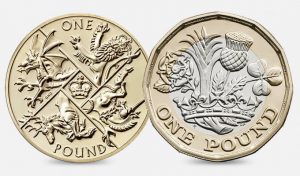
The old Round Pound and the new 12-sided £1 coin
British news outlets are reporting that millions of the old round pounds are still in circulation but that might not be bad news for many Britons. There are reports that many coin-operated systems have not been converted to take the new 12-sided £1 coin including supermarkets, where a £1 pound coin is necessary to “rent” a trolley, what the British call their shopping cart.
Two of the U.K.’s largest grocery store chains have announced they will continue to accept the round pound through the end of October because their trolley systems are not ready.
Charities are getting into the act by accepting the old round pound as donations. Many charities will continue to accept the coin through the final redemption period in March 2018 as donations. The charities are working with banks to deposit the coins.
It has been fascinating to read the news of how the U.K. has tried to adapt to the new coin. The biggest issue has been with the use of coin-operated equipment like trolley rentals and parking meters. It is a lesson to any active economy, such as her in the United States, as to what could happen should the composition of U.S. coins change.
Although there have been discussions as to whether to change the composition of United States coinage, it is not likely to happen for many reasons. What may be gaining support is dropping the $1 Federal Reserve Note in favor of a dollar coin. This would not require changes in coin-operated systems but a change in attitudes. Given how resilient Americans can be, it would be possible to end production of the $1 FRN and just endure the kvetching that will ensue. That will end when people get used the coin.
And now the news…
October 9, 2017
LeRoy Transfield A photo of the New Zealand Expeditionary Force, Native Contingent. Utah sculptor LeRoy Transfield had two uncles who served in the unit during World War I. → Read more at deseretnews.com
October 11, 2017
The discovery of gold rings and coins on a Swedish island sheds new light on the history of the area, and could give insight into the motives for a massacre which took place in the fifth century, archaeologists told The Local on Wednesday. → Read more at thelocal.se
October 12, 2017
Share → Read more at adweek.com
October 12, 2017
People buy gold in various forms like jewellery, coins etc. Here are 7 things to know if you are buying gold coins this Diwali. → Read more at economictimes.indiatimes.com
October 13, 2017
The Carl Brashear Foundation wants to bring its namesake’s legacy home to the veterans center that soon will bear his name. → Read more at thenewsenterprise.com
October 14, 2017
By Katie Lange Defense Media Activity → Read more at dodlive.mil
October 15, 2017
Shoppers have one day left to spend their old round £1 coins before they cease to become legal tender at midnight. Hundreds of millions of round pounds are yet to be handed in, as only hours remain before the coin drops out of general circulation. However, major banks and building societies have said they will continue to accept the old coins after the deadline on Sunday. They can also be deposited into any of the usual high street banks or through the Post Office. → Read more at independent.co.uk
October 15, 2017
Sunday, October 15, 2017 → Read more at jamaicaobserver.com
October 15, 2017
Currency modernization will help secure our financial futures and save billions of dollars for taxpayers. → Read more at cnbc.com
Oct 12, 2017 | Britain, coins, counterfeit, errors, foreign
 As the British are winding down the use of the Round Pound, stories are once again popping up about errors of the new 12-sided pound coin being sold for high prices on eBay.
As the British are winding down the use of the Round Pound, stories are once again popping up about errors of the new 12-sided pound coin being sold for high prices on eBay.
Although the Royal Mint has admitted to manufacturing issues in trying to produce enough new pound coins to satisfy circulation requirements, their claim that the number of errors where the center are missing of the bi-metallic coins is likely post-minting errors.
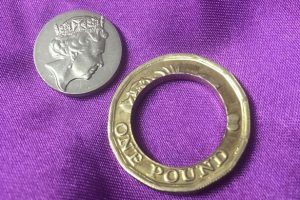
A weak strike can prevent the two metals from fusing properly allowing them to separate
To better understand why it is being claimed these are post-mint errors, I contacted a European-based dealer who has relationships with many of the continent’s mints. What follows is a summary of his explanation.
The Royal Mint coins money in a process similar to any other mint. Planchets are prepared, sent the coining press, stamped, dumped into a hopper, and sent down a conveyor where they are bagged. The bags are weight to a precise weight before the bags are accepted. Along the way, there are cameras and other sensors to detect errors.
All of the checks and sensors, including the weight of the coin, would be caught long before reaching the bagging section. Aside from the dimensions not being correct, the weight of the ring or center by themselves would not be up to the standard.
It is possible that the coins could separate in the bags during transport. However, these coins are transported to government authorized handlers. Some of them are similar to the companies that drive armored trucks here in the United States. They take the coins and prepare them for delivery to the banks.
The preparation process requires coins to be counted, rolled, and bagged. As part of the process, the coins are loaded into a system that transfers them to an automated line that brings the coins by conveyor to a machine that will either roll them or dump them in a bag. In both cases, the contents are limited by the amount they hold.
As part of the automated system, the coins are counted and check for size and weight so that if there are any coins that do not meet the Royal Mint’s standards are removed. The automated system would catch the ring and the center if they separated before the process.
Coins that are to be rolled are sent to a machine to roll them where they are counted and placed in rolls of £25 each. Those rolls are for bank and retail use and handled accordingly.
Bagged coins are used by bulk handlers such as the coin-op industry. Bags with £100 of coins are counted before being placed in the bag. If the coin cannot be verified before it is placed in the bag then the coin is rejected.
Is it possible for the coin to separate in the £100 pound bag prior to circulation? Of course, it is. However, there is one more check before the coins reach the consumer, and that is the coin-op machine itself.
Coin-op machines have mechanisms to try to prevent accepting counterfeit money and to ensure it is giving the proper change. Machines just do not eject any coin in its hopper. These checks include the weight, dimensions, and magnetic signature. The magnetic signature measures what happens after magnetic energy is flashed on the coin. Think about it as measuring how the coin would reflect light but use magnetism instead.
A pound coin that had separated would not pass the magnetic signature test and be rejected.
Although there are a number of points along the process that could fail, the number of checks between the Royal Mint and the consumer, it is highly unlikely that all of these separated pound coins exist.
It is possible that the coins being sold are from the reject bins of coin-op machines. However, the dealer I spoke with is suspicious of the number of coins being sold.

Trial strikes found without the effigy of Queen Elizabeth, II
My dealer contact said that nobody should pay more than “three-and-a-half quid” (£3.50 or $4.64 at the current exchange rate) for just a 12-sided pound outer ring. Even if it is not a legitimate Royal Mint error it is a nice conversation piece.
Examples of legitimate 12-sided £1 coin errors
-

-
Too hard of a strike is likely to have caused the copper-nickel center to melt across the coin.
-

-
First new £1 coin error found with missing detail on the thistle
Oct 7, 2017 | Britain, currency, foreign
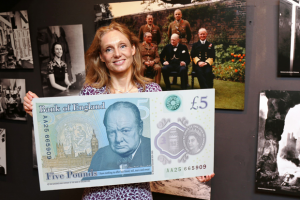
Victoria Cleland, Chief Cashier at the Bank of England, presenting the Churchill War Rooms with their New Fiver
Tallow is made from suet, the fatty deposits around the organs of cows and sheep. It is a byproduct of the process of butchering a cow for its meat and hides. In its natural form, suet is only used for cooking and some preservation. When it is rendered (by boiling) into tallow, it is used to manufacture soap, candles, and lubricants. The use of tallow in even the most synthetic lubricant is ubiquitous. Machines used to harvest crops or grease moving parts in automobiles have tallow in them.
Since the uproar from vegan activists, the Bank of England spent a lot of time and a lot of money to research the environmental and social impact of tallow in the notes.
The amount of paperwork that was generated for this issue is astounding. They looked at everything from the use of alternative lubricants, like palm oil, to the religious and social impacts to Her Majesty’s loyal subjects. In the final report, the Bank of England even summarized the response when they reached out to “representative groups,” both religious and activists organizations.
All that time and money led to the decision to “ not change the composition of the polymer used for future notes.” Why? Because the costs and environmental impact to using alternatives like palm oil would be more expensive, the notes have such low amounts of tallow, typically less than 0.05-percent (five-one-hundredths of a percent) of derived animal products, and the rest of the community just does not see this as a problem!
It is like I said in my original post, they are probably breathing more dander in a single day than they are touching tallow in all of the polymer banknotes that cross their paths. Tallow is used in all sorts of lubrication products, especially those used in transportation. It is everywhere.
I hope the vegans can either learn to live within society’s decisions or find another way to pay for goods and services, like using credit cards.
Sep 22, 2017 | foreign, medals, news
On Thursday, September 21, 2017, the PyeongChang Olympic Committee unveiled the design of the medals that will be awarded during the 2018 Winter Olympics.

2018 PyeongChang Winter Olympics Medals
According to the PyeonChang Olympic Committee, the design of the metals is inspired by Korean culture and traditions. The texture of the metals are intended to symbolize tree trunks representing the trees symbolizes the work that has gone into developing Korean culture. Edge lettering includes did the games in both English and Korean.
The ribbon that will be used on the medals has been created using Gapsa, a traditional Korean fabric that is used to make Hanbok. Hanbok is a type of traditional Korean dress.
The medals were designed by Lee Suk–woo, serves as a Director of Dongwon Metal Co., Ltd. Lee is the company’s General Manager and creative director. He is a graduate of Eastern Michigan University.
Medal Specifications
- GOLD: 586 grams made from .999 silver and plated with 6 grams of gold
$566.55 melt value with a silver spot price of $16.87 and gold spot price of $1289.30
- SILVER: 580 grams made from .999 silver
$317.84 melt value with a silver spot price of $16.87
- BRONZE: 493 grams made from .900 copper and .100 zinc
$2.97 melt value with a copper price of $2.8837 per pound and zinc price of $1.3932 per pound
- All medals are 92.5 mm in diameter period
- Medals range in thickness from 4.4 mm at its thinest to 9.42 mm at its thickest
Medal Design
Uses consonants of Hangeul, the Korean alphabet system extended across the face of the medal from its side
- Obverse: Olympic rings
- Reverse: Discipline, event, and PyeongChang 2018 emblem
- Edge: Official title of the PyeongChang 2018 Games in the Korean consonants
Medal Case
- Wooden cased designed with curves witnessed in Korean traditional architecture as the motif translated into a modern concept
- Contains the medal, medal description, the IOC badge, and medallist note
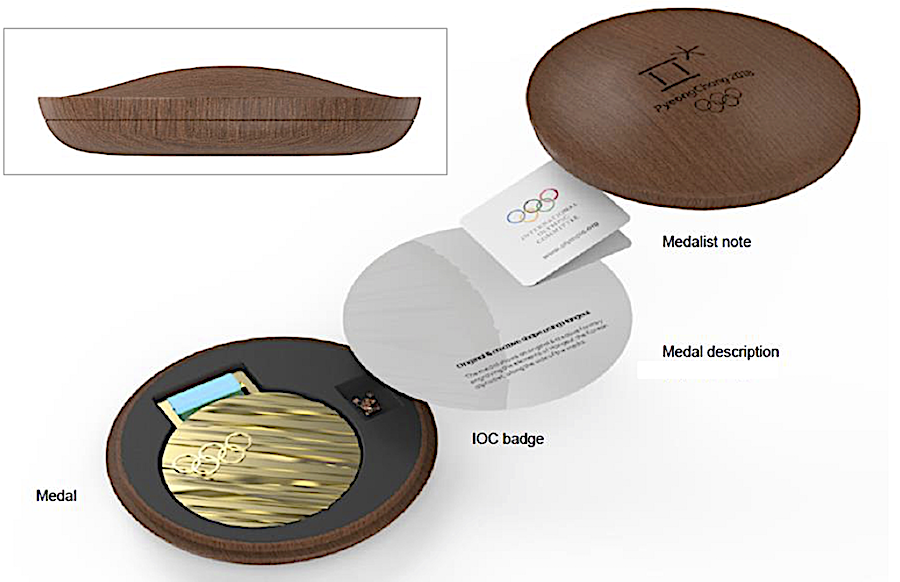
Wooden case given to 2018 PyeongChang Winter Olympics medalists
Medal Production
Quantity: total 259 sets
- 222 to be awarded to athletes (102 medal events)
- 5 sets as contingency in case of tie
- 25 sets to be submitted to the IOC
- 7 sets for display in Korea
Produced by the Korea Minting, Security Printing & ID Card Operating Corporation (KOMSCO)
All images courtesy of the 2018 PyeongChang Olympic Committee.
Sep 4, 2017 | currency, foreign
When you are a picker sometimes a find can be worth more than originally expected.
This past week I was offered a small library of military books from the estate of a former career military officer. Normally, I will not invest too much into books since they are not big sellers. However, if I can find certain military books at a good price, I will buy the entire lot for what I know will sell and take my chances on the rest.
As I was thumbing through the books, I found papers with various notes. The former owner did not like writing in the book. Rather, he would write his notes on papers and leave them between the pages. He would also use different objects as bookmarks. I found everything from business cards to old identification cards. And not just his identification card. There were cards from other people along with a lot of black and white pictures.
Since the books were handed down from his father, there were a number of early editions, especially books about Germany and Europe leading up to World War II. His father may have been an analyst since there were papers with insight beyond the written pages. I will be looking to donate some of this to a university or museum for them to study.
But I did find something numismatic between the pages. A 20 Reichsmark Bank Note from January 22, 1929. In trying to learn more about the note, the front has a portrait of Ernst Werner von Siemens, the founder of the electrical and telecommunications company Siemens.
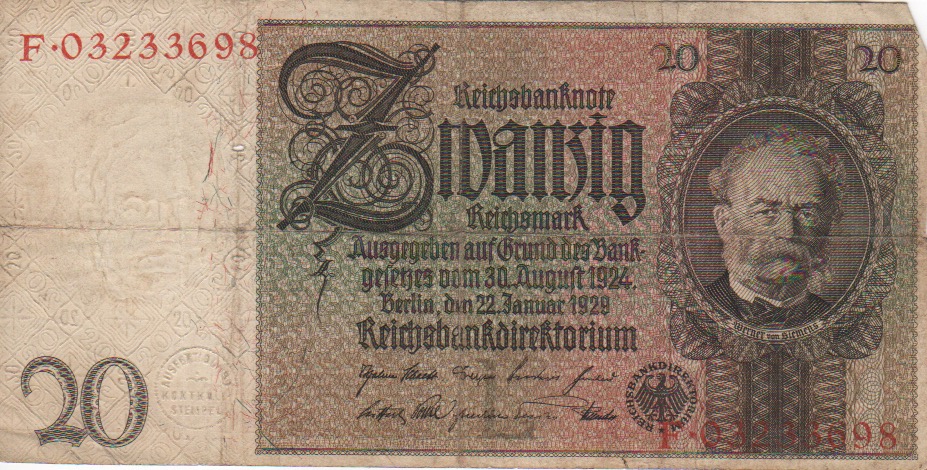
1929 Nazi Germany 20 Reichsmark banknote (front) — Pick #181a
The back of the note has a worker’s medal with angels surrounding the medal. Written in small letters across the bottom of the note is the following:
WER BANKNOTEN NACHMACHT ODER VERFÄLSCHT ODER NACHGEMACHTE ODER VERFÄLSCHTE SICH VERSCHEFT UND IN VERKEHR BRINGT, WIRD MIT ZUCHTHAUS NICHT UNTER ZWEI JAHREN BESTRAFT
According to Google translate means:
Anyone who imitates or distorts banknotes, or imitates or falsifies himself and puts them into circulation, shall not be punished with brethren under two years
In other words, there is a minimum of a two-year sentence for counterfeiting this note.

1929 Nazi Germany 20 Reichsmark banknote (back)
Although a cool find, this is not the type of item that would fit into my collection. I am likely to sell it to the next collector.
Aug 21, 2017 | ancient, coins, commentary, foreign
As we wait for the shadow of the moon to trek across the United States from Oregon to South Carolina, I was curious as to whether there were coins ever created to commemorate any of the past eclipses regardless of location.
Allowing an online search engine to help, I was able to find a few coins.
-

-
1999 Alderny Total Eclipse of the Sun Commemorative Five Pound Coin
-
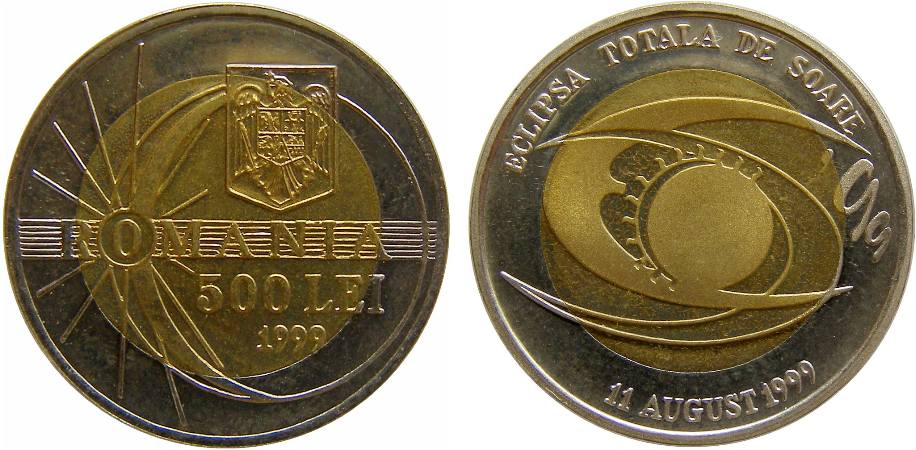
-
1999 Romanian Eclipse 500 lei bi-metalic commemorative coin
-
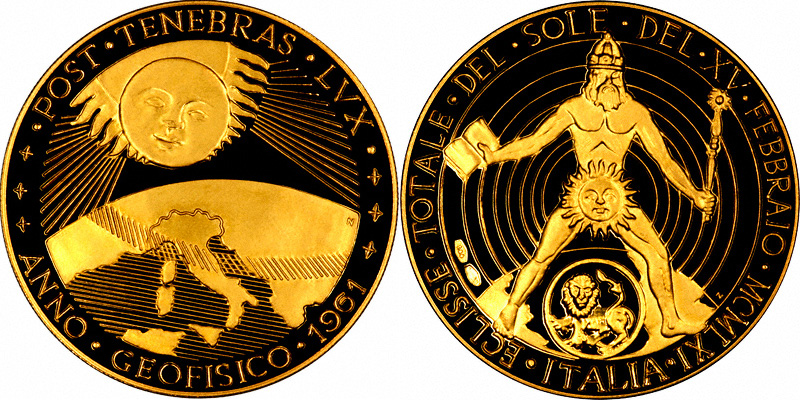
-
1961 Italy Total Eclipse of the Sun Gold Medallion (Image courtesy of Chard)
-

-
Minting of these coins in Nikopolis could indicate an eclipse focused on that region
I am sure there may be a few more, but I need to run out to pick up a pair of those funky glasses!
Jun 13, 2017 | counterfeit, currency, foreign
As I continue my research into history and technology of counterfeiting, I have been collecting historical statistics as to the problem of counterfeiting. I thought I would share the current statistics I found.
The most common counterfeited denomination is the 20s, be they dollars, pounds, euros, or pesos. For currencies whose values are significantly lower than the dollar, such as the yuan, or whose currencies have no real fractions, like the yen, the most common counterfeited denomination is the 100 unit.
Canada

The top note is a counterfeit $100 note, the bottom is a legitimate note
United Kingdom

Detecting counterfeit £1 coins, the genuine coin has edge lettering (left), the counterfeit does not.
The Bank of England began issuing currency using the polymer substrate starting with the £5 notes. The paper fiver was withdrawn on May 5, 2017 (withdraw the £5 on 5/5… get it?!). Plans continue to issue the £10 note in September.
The move to polymer notes was prompted because of a spike in counterfeiting in 2012. Spiking at more than 746,000 counterfeiting notes with a value of £13.71 million, the Bank of England reports that 347,000 counterfeit notes valued at £7.47 million were confiscated in 2016.
Euro
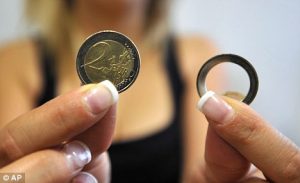
Eurozone has had more problems with counterfeit €2 coins than currency.
The ECB is in the process of transitioning their currency to the new Europa Series. A new €50 note was issued this past April. Aside from new designs, the Europa series uses some of the advanced technologies to prevent counterfeiting but does so on cotton bond. Currently, there is no plan to use the polymer substrate for the Euro notes.
China
As opposed to other central banks, the People’s Bank of China (PBC) is not as forthcoming with information. But when they do something, news reporters can obtain some nuggets of information from Chinese officials. When the PBC unveiled new 100 yuan notes with additional counterfeiting features, they reported to the Wall Street Journal that police confiscated 532 million yuan ($85.6 million) in counterfeit bills in 2014. The most commonly counterfeited notes were 50 yuan and 100 yuan bills but there have been increases in lower denominations.
Mexico
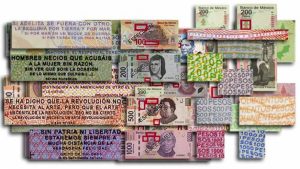
Click on the image to read a nice description (in English) on identifying genuine Mexican currency
Statistics published by the Bank of Mexico reports a decrease in the number of counterfeit currency from 70.7 per million issued to 61.8 per million notes issued. This represents a decrease of 12.6-percent. When the Bank of Mexico issued the new polymer 20- and 50-peso notes in 2014, they experienced a drop in 36.9-percent in counterfeiting.
United States
It is not a surprise that the world’s most use currency and the currency that most world trade is based is the most counterfeited currency in the world. There is also more United States currency in circulation that any other, including the Euro. According to the Federal Reserve, there is approximately $1.49 trillion in Federal Reserve notes circulation. The Federal Reserve Bank of San Francisco says that 31.1-percent of those notes is the ubiquitous dollar and 26-percent are $100 Federal Reserve Notes mostly held overseas.
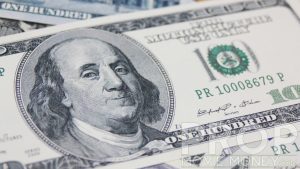
Prop Movie Money continues to be a problem because people just do not look!
The $20 bill is the most commonly counterfeited banknote in the U.S., while overseas counterfeiters are more likely to make fake $100 bills.
In every report downloaded from the various governments and central banks regarding the security of their currency, it is a common theme that the vast majority of counterfeiting would have a minimal impact if people would just look for the anti-counterfeiting measures these entities go through great lengths to add to the currency. Whether it is not looking for the edge lettering on the old round-pound or the recent cut-and-paste of the security features of Canadian currency, there would be few problems if people would just look.
Credits
- Canada counterfiet currnecy image courtesy of CTV News.
- Counterfeit round-pound image courtesy of BBC News
- Counterfeit €2 coins courtesy of The Daily Mail
- Mexican currency image courtesy of Bajainsider.com.

 → Read more at korea.stripes.com
→ Read more at korea.stripes.com → Read more at timesofisrael.com
→ Read more at timesofisrael.com → Read more at asahi.com
→ Read more at asahi.com → Read more at philstar.com
→ Read more at philstar.com → Read more at bangkokpost.com
→ Read more at bangkokpost.com → Read more at business.inquirer.net
→ Read more at business.inquirer.net → Read more at bbc.com
→ Read more at bbc.com → Read more at trektoday.com
→ Read more at trektoday.com



























